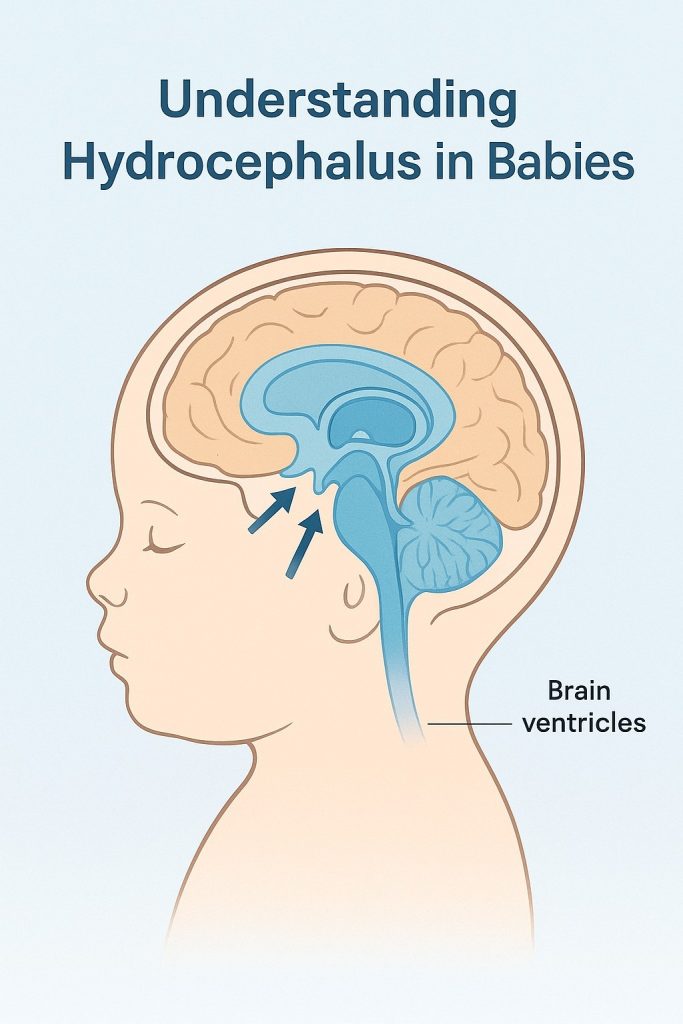“Water in the head” — that’s what the Greek-derived word hydrocephalus means. The sight of a baby with hydrocephalus is unforgettable. The head is greatly enlarged while the face remains small. The eyes often stay in a downward gaze, sometimes deviated left or right. The child’s small neck can barely hold up the head. The scalp veins bulge. And if you run your hand over the skull, you may feel a vast soft defect at the front. Truly, it is quite a sight.
The good news is that effective treatments are available and you can learn about them in this article.
The Disease Process
How does hydrocephalus occur? Well, like the heart, the brain has four chambers called ventricles, filled with a fluid it produces — the cerebrospinal fluid (CSF). When too much of this fluid accumulates in the ventricles, hydrocephalus develops. This excess can result from:
- Overproduction of CSF
- Obstruction in its flow
- Poor absorption into the bloodstream

Types of Hydrocephalus
Congenital Hydrocephalus
This is hydrocephalus a baby is born with. It is the commonest type and often occurs with other birth defects involving the spine, limbs, or heart.
Acquired Hydrocephalus
This type develops after birth when something interferes with CSF flow. Common causes include brain infections such as meningitis, brain bleeds during a difficult birth or after an accident, and brain tumours that develop later in life.
Signs and Symptoms
Some symptoms appear mainly in infants whose skull bones are still unfused:
- Big head
- Bulging scalp veins
- Delayed or lost developmental milestones
Other symptoms, especially in older children, include:
- Headaches worse in the morning
- Vomiting
- Abnormal gait
- Drowsiness or irritability
- Seizures
Complications
When CSF builds up, it raises pressure inside the skull and stretches delicate brain tissue. Over time, this can damage brain regions responsible for thinking, vision, and movement. If fluid accumulates rapidly, breathing may fail, and death can occur.
Common complications include:
- Intellectual disability
- Behavioural problems
- Visual impairment
- Limb stiffness or difficulty walking
- Inability to control urine
- Respiratory arrest in severe cases
Treatment
Hydrocephalus is treatable with surgery.
Shunt Surgery
The commonest method involves inserting a shunt — a narrow tube that drains excess CSF into another body cavity, most often the abdomen. Sometimes, it may drain into the chest or heart.
Endoscopic Third Ventriculostomy (ETV)
This alternative procedure is done entirely within the brain to relieve obstruction and allow CSF to flow freely. It is less common but effective in selected cases. You can read more about it here.
Medications and Temporary Measures
While preparing for surgery, doctors may prescribe drugs like acetazolamide to temporarily reduce CSF production. However, this is only a short-term measure — surgery is still needed for a lasting solution.
In some babies with hydrocephalus caused by bleeding, the surgeon may first observe if it will resolve on its own. But if it becomes critical, an emergency shunt may be inserted.
Prevention
It is not always possible to predict which child will be born with hydrocephalus, but some measures can help reduce the risk.
1. Take Folate Before Pregnancy
Start taking folic acid daily at least one month before conception. This is especially important if you have previously had a child with birth defects.
2. Do an Anomaly Ultrasound Scan
Between 18–22 weeks of pregnancy, an ultrasound can detect birth anomalies such as hydrocephalus. Early detection allows for better planning and care.
3. Attend Antenatal Care and Ensure Safe Delivery
Antenatal care helps identify risks for preterm or difficult delivery — both of which can cause brain bleeds and later hydrocephalus. Always deliver under a skilled birth attendant such as a doctor, nurse, or midwife, preferably in a hospital.
4. Vaccinate and Treat Infections Promptly
Brain infections like meningitis can lead to hydrocephalus. If you or your child develops one, ensure full hospital treatment, often lasting 7–21 days. Do not leave early — consider the future. Some of these infections are preventable through vaccination.
5. Prevent Head Injuries
Use seat belts, safety seats, and helmets. If a head injury occurs, seek prompt medical attention.
Conclusion
You can take your first steps to preventing hydrocephalus now. Use your seatbelts, immunize your babies, take your folate. Start small, yes — but start now.
Another condition that damages newborns’ brains is jaundice. Learn about it here.









